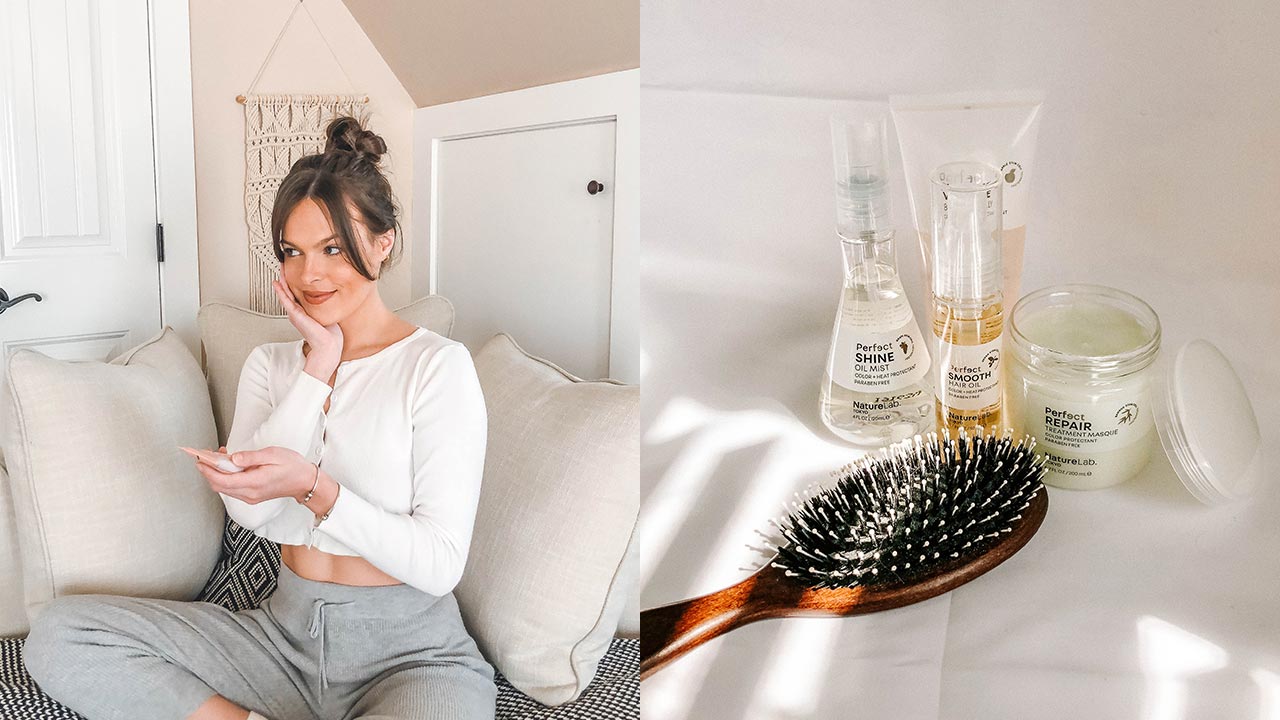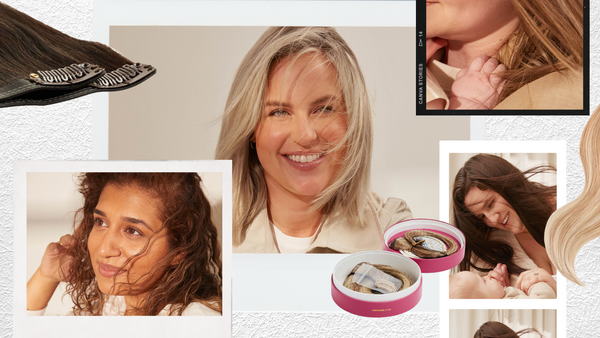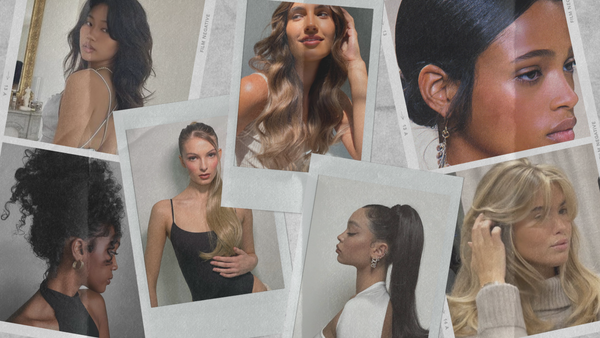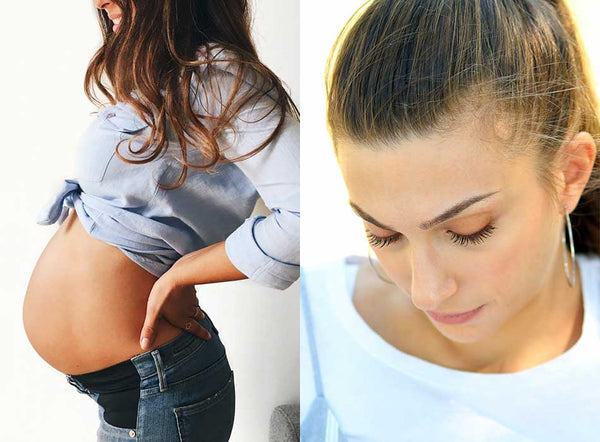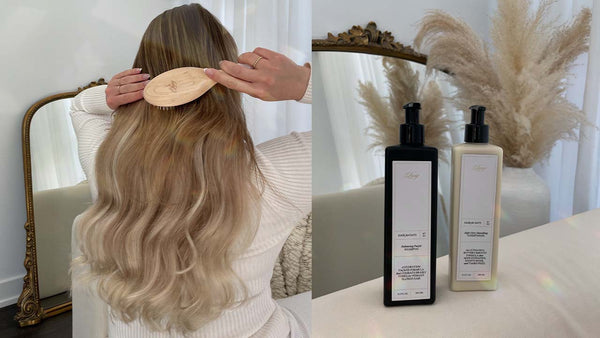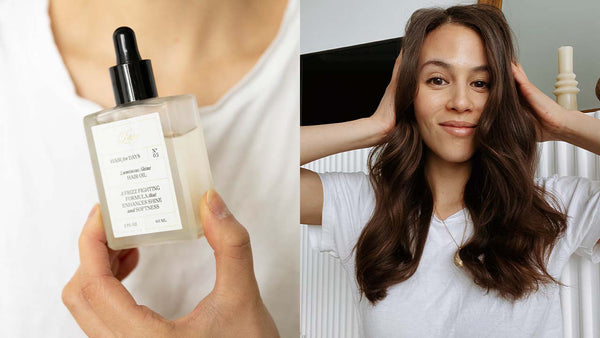Pimples always pop up in the most unwelcome places—cheeks, foreheads, and yes, even the hairline. The good news is hairline acne is common and is usually easily treated with a few simple steps.
What is hairline acne? Just as it sounds, it’s when pimples (made up of excess oil and build-up of dead skin within a pore) appear along the top of the forehead where your hairline starts. Scalp acne is also a thing, but is treated differently...more on this later.
 Image by @maggiemccormack
Image by @maggiemccormack
What causes hairline acne are usually the same culprits that cause pimples and acne to appear on our face, back, and other body parts. It comes down to excess oil in the skin, hygiene, and external irritants such as pore-clogging makeup, bacteria, and headwear. Genetics and hormones also come into play for certain types of acne and breakouts and should also be considered as causes of hairline acne.
Here are the most common causes of those pesky pimples and how to get rid of hairline acne.
Causes and treatments of hairline acne
 Image by @maggie_mccormack
Image by @maggie_mccormack
Excess Oil
Just as those with oily skin are more prone to pimples on the face, the same goes for hairline acne. Our skin naturally contains oil glands that produce sebum, the body’s natural way to lubricate skin and hair. It is the buildup of sebum within a pore, however that causes redness, swelling, and irritation which manifest as pimples.
Some of us are just more naturally oily than others, and that’s OK. Having a regular skin routine that involves thoroughly cleansing and moisturizing the skin can help to combat facial acne, effectively getting rid of hairline acne too. Look for ingredients such as tea tree oil to help cleanse the skin and get rid of bacteria. Many facial washes, shampoos and conditioners contain tea tree oil as an antibacterial to help get rid of hairline acne. Argan oil is also an ingredient to look for, as it has anti-oxidant and moisturizing properties that will benefit both the hair and skin, helping to reduce skin irritations like acne while still providing moisture.
 Image by @maggie_mccormack
Image by @maggie_mccormack
Hairline acne and scalp acne are very closely linked, as both are most commonly caused by excess oil. Scalp acne will usually occur if there is also inflammation and irritation around the hair follicle. Dandruff, a common sign of an imbalance in the scalp, can occur in both an oily scalp (making you prone to both scalp and hairline acne) as well as a dry scalp where the skin can flake off. Dry scalp can cause further irritation and itchiness, which doesn’t help when dealing with scalp acne. To best deal with scalp acne is to ensure your scalp is healthy. This is also the foundation for healthy hair and using a scalp scrub can help get rid of hairline acne and scalp acne. A scalp scrub works by going beyond the surface to remove dryness, excess oil and product build-up, and even boosts circulation—the root of strong hair growth.
Heavy hair products
 Image by @maggie_mccormack
Image by @maggie_mccormack
Scalp scrubs can do wonders for your scalp and hair, but are you also using the right shampoo, conditioners and other hair products that keep your hair healthy? Or are your hair products weighing you down?
Heavy hair products such as pomade or hair clay contain ingredients that clog pores and glands, and oil-based hair products can also do the same, if not used correctly. Thick shampoos and conditioners can also be loaded with chemicals and ingredients that may smell and feel great but are wreaking havoc on your hair and skin. Other products such as hairspray and dry shampoos can also sometimes contain sulfates or and similar chemicals that can dry your skin and hairline causing your skin to go into overtime to produce more sebum than necessary, causing more oil and a breeding ground for pimples.
Take a good look at the ingredients list of your hair and skin products, and look for products that have noncomedogenic ingredients. Noncomedogenic products help hydrate the skin without clogging pores.
 Image by @maggie_mccormack
Image by @maggie_mccormack
Be sure to wash your hair regularly and get rid of any excess hair product to prevent buildup, which can cause hairline acne. If switching hair products and your regular washing routine doesn’t seem to get rid of hairline acne, it’s best to get help from a dermatologist or doctor. There are topical options that can help treat hairline and scalp acne in extreme cases. Shampoo or topical skin treatments with 1-2% of salicylic acid can help get rid of acne, in more severe cases.
If you’re active and love a good sweat, be sure to wash and cleanse your face and hairline after a workout. It’s easy for pimples to appear if you allow sweat, oil and bacteria to build up after a workout. If you’re pressed for time, there’s no harm packing moisturizing facial wipes for a quick fix before you can cleanse and wash your face thoroughly. For your hair, pack some dry shampoo or take a couple minutes to spray a little heat protectant and quickly blow-dry the hairline on low heat. These quick steps after your workout can help prevent hairline and facial acne while still allowing you to get your fit on.
Pore-blocking makeup
 Image by @maggie_mccormack
Image by @maggie_mccormack
Full coverage makeup that give us that flawless look is always welcome, but just like heavy hair products, our favourite cosmetics can also be causes of facial and hairline acne. It’s easy to apply makeup all over your face, but are you as meticulous about cleaning it all off? Especially around the hairline? Allowing makeup to buildup will clog pores and irritate the skin, causing pimples—especially around the hairline.
Try to avoid wearing heavy makeup such as liquid foundation or concealer near your hair and hairline and always thoroughly wash off makeup before bed—for all you lazy ladies, pop on your favourite podcast or Netflix show while performing your skincare routine to make this process more enjoyable!
Be sure to wash your brushes and sponges thoroughly or replace them regularly too. These makeup tools are breeding grounds for bacteria which cause acne and other skin irritations.
Hormones and genetics
No matter how well we clean or wash our hair and skin, sometimes oil build-up is simply hereditary. Practicing good hair routines, however, will still help get rid of hairline acne, even if you have to be a little more diligent than others. The texture, length and thickness of hair also depends on hormones and genetics.
Hormonal changes, including *that time* of the month can also make women prone to breakouts. If you find hairline acne only appears from time to time take note of when it’s happening as it could be attributed to hormonal factors or medications that impact hormones.
Headwear
 Image by @maggie_mccormack
Image by @maggie_mccormack
Whether it’s something cute to complement an OOTD or a band to keep sweat from getting in your eyes during Pilates, hats, headbands or sweatbands are great accessories, but they can also be the causes of your hairline acne. Ever notice a yellow or brown tinge on your headbands or hats? That’s dried sweat and bacteria, also common in the underarm areas of your favourite t-shirt. Hats and headbands, especially worn during working outs or hot weather trap sweat, oil and bacteria. When worn for long periods of time or worn consistently without being thoroughly cleaned or washed can cause hairline acne.
If you’re a hat-lover, don’t let this kill your style, be sure to wash the inside of your hats and avoid wearing them for prolonged periods of time, especially during a sweat session. Pack your gym bag with a few clean headbands so you can alternate during the week.
Keep your hands off
Simple, good hygiene means anytime you touch your face or hair, apply makeup or even style your locks, your hands should be clean.
Avoiding over-touching your hair and skin can also help prevent the transfer of bacteria and oils from our hands to our hairline and face. If you think this isn’t you, a study has found that the average person touches their face up to 3,000 times a day! This doesn’t even count how many times you run your fingers through your hair or tuck your hair behind your ear. It’s a habit that can’t be totally avoided but being more aware of it will help prevent the transfer of oil, dirt and bacteria to the places we really don’t want it most.
 Image by @maggie_mccormack
Image by @maggie_mccormack
Never pop a pimple
It’s one of the first pieces of skin and beauty advice you get as a teen when pimples just start showing up: don’t pop a pimple. Yet, why is our first instinct sometimes to squeeze, pick, or pop these little irritants away?
As previously mentioned, a pimple is a build up of oil and bacteria. When they appear it means the body is working to get rid of this excess build-up. Despite their horrid appearance, pimples are actually a sign that your body is doing something good. When you squeeze or press on a pimple, you may actually be pushing the bacteria and oil further into the skin—and even worse, could even be spreading it causing more pimples to appear.
If you are successful in popping the pimple, you may feel a short sense of satisfaction, but now you’ve broken the skin and actually caused an open wound. If your hands aren’t clean while performing this no-no task, you’re also transferring more dirt and bacteria into this now open wound from your fingers. This can cause further irritation and make the pimple even worse. By breaking the skin and possibly spreading bacteria, this can lead to scarring which takes weeks or even longer, depending on your skin type, to heal.
All of the above is to say popping a pimple simply is not worth it and does nothing but actually make the situation worse. So, whether it’s on your hairline or on your nose, cleanse and treat as advised above, but do not squeeze, press, pick or pop it.
 Image by @maggie_mccormack
Image by @maggie_mccormack
Getting rid of hairline acne can be done
No matter where it shows up, dealing with acne is never fun. Most causes of hairline acne are preventable and it’s treatable in most cases. Don’t let a few pimples on your hairline get you down, simply give your hair and skin a break by not touching so often, cleanse your face and hairline, avoid skin-clogging products, and manage any extra oil. A few simple steps and good habits to carry on will get rid of that hairline acne in no time.
Written by: Rosalyn Solomon
